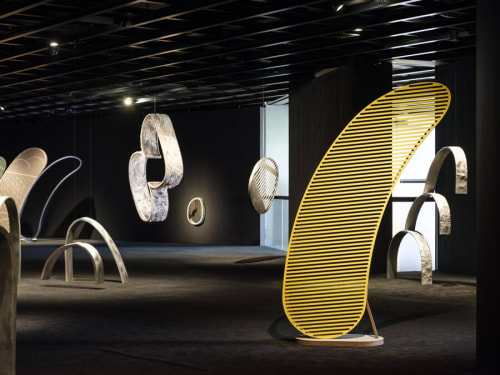In 1751, during the late Joseon dynasty, the artist Jeong Seon broke with the tradition of idealized, imagined landscapes in Korean ink painting by faithfully depicting the mist rising after rainfall at Mount Inwang (Inwang Jesaekdo). Nearly three centuries later, Suki Seokyeong Kang is presenting her own interpretation of the same subject at Leeum Museum of Art, where Jeong’s painting is now housed. Comprising a series of curved reliefs that resemble mountain ridges, from which delicately hang metal chains and threads, Mountain (2020–ongoing) – installed in the museum’s white-walled lobby – introduces visitors to a practice that transcends individual works to create an immersive viewing experience.
While Kang majored in Korean painting, her interests are interdisciplinary, ranging from music and dance to architecture. Her series ‘Jeong’ (2014–ongoing), for instance, draws on Jeongganbo – a traditional Korean musical score, which notates the length and pitch of a note in each section of the grid-like Chinese character jeong (井). Having initially transposed this conceptual unit of time and narrative onto canvas in works such as Jeong 井 58 × 78 #06 (2014), Kang later expanded her exploration into freestanding sculptural pieces like Jeong – Willow #22–01 (2020–22), comprising curved poles from which dangle bunches of dyed rush and support a mirror engraved with text.
In works from the ‘Warm Round’ (2012–ongoing) series, such as Warm Round 460 #21–01 (2021), Kang weaves wool tightly through the contrasting material of wire mesh to create surprisingly harmonious, small-scale works that frequently become components in other sculptures. The grass-green head of the anthropomorphic, tree-trunk-and-leather Narrow Meadow #20–05 (2020), for instance, references the series, hinting not only at a degree of permeability between the works on display, but even between artwork and viewer.
The title of Kang’s 2018 show at the Institute of Contemporary Art, Philadelphia, ‘Black Mat Oriole’, drew on the traditional solo court dances of the Joseon dynasty, performed on a hwamunseok, a woven mat. Likewise, the title of this exhibition, ‘Willow Drum Oriole’, is borrowed from gagok – a genre of Korean song whose lyrics describe the movement and sound of oriole birds flying through willow trees, as if weaving a thread into the fabric of the landscape. A new video of the same name, screened on a wall in the lobby, activates the other works on display: images of enlarged, reduced or cropped sculptures float and slide along the horizon. At one point, two figures, whose feet alone are visible, carry a flat canvas behind them. The audio – which encompasses a range of sounds from clanging metal to wind and raindrops – fully envelops viewers.
Meticulously constructed, occasionally divergent routes through the show suggest myriad ways in which to experience Kang’s art. This unconventional method of installation succeeds to varying degrees. In the busy museum lobby, for example, it is difficult to contemplate the artist’s sculptural series ‘Hours – Two’ (2020–23) among the crowds of visitors. On the gallery’s lower floor, however, the architectural installation Mat #22–01 (2021–22) and works from the spacious, stool-like ‘Day’ series (2021–23) provide the simple pleasure of sitting, looking and reflecting. On the upper floor, works from ‘Mountain – Hours’ (2020–21) – a series of graceful, softly lit, aluminium sculptures suspended from the ceiling – form a constellation with Floor #23–01(2020–23), a column-like sculpture which stretches up from the ground. Wandering between these works, we are enfolded, as in one of Kang’s woven sculptures, into the fabric of her heterogeneous landscape.
Suki Seokyeong Kang, ‘Willow Drum Oriole’, is on view at Leeum Museum of Art, Seoul, until 31 December.
—Hayoung Chung


